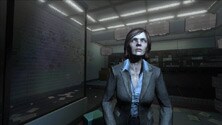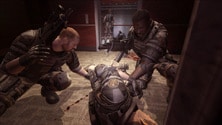|
Fear is a very subjective feeling. What scares one person may seem tame to another. It’s for this reason that many horror movies and games resort to cheap thrills and quick moments of terror, like enemies jumping out from corners to scare gamers. Released in 2005, Monolith’s F.E.A.R. was different. Channeling the one thing that scares all of us; the unknown – F.E.A.R’s developers crafted a chilling tale, mixed with fun gameplay and rock solid mechanics.
While F.E.A.R. 2: Project Origin does retain some of its predecessor’s best points, it falls back on too many genre clichés, and doesn’t really do anything to advance the franchise. The developers seemed to follow the old adage of “if it’s not broke - -don’t fix it,” and while it may not be revolutionary – it’s still damn fun.
Project Origin starts off mere minutes before a nuclear bomb went off at the end of the original game. You control Delta Force agent Michael Becket, charged with capturing Genevieve Aristide, the president of the Armacham Technology Corporation. Bridging the two stories together so closely is a novel approach, but may leave those who have yet to experience the original F.E.A.R. a bit lost. Without giving too much away, the Armacham Corporation is a attempting to harness the powerful psychic abilities of Alma (the creepy girl who looks like she’s from The Ring).
 |
|
| |
|
Alma’s appearances were at the core of what made the original F.E.A.R. so creepy, but in the sequel she loses some of that muster. We now know just what she is, and what she can do – and while her "corner of your eye" appearances may startle you a bit, they’re almost expected. Luckily, the creepy ambiance and surroundings will more than make up for some of the lackluster frights. The audio, from the creepy floor creaks, to the inane radio chatter and the pitch perfect music will have you on the edge of your seat even when you’re not confronting the paranormal.
At its best, Project Origin’s level design aids the developer’s in their goal of scaring players out of their wits. In levels like the deserted school ( which by the way, is one of the creepiest experiences I’ve had in gaming), the game embraces its roots as a corridor shooter, and it feels natural – yet other levels, like the city streets somehow feel constricting and too open at the same time. You’re given the illusion of freedom, yet somehow the scraps and destruction fell so perfectly that it created a path for you to walk down. A few of the levels, like one that finds you piloting a Mech, do offer distractions from the frag-fest, but there just aren’t enough of them and they end up feeling tacked on.
The good news is that the mechanically sound and incredibly fun gameplay of the original F.E.A.R. transfers over quite nicely to the sequel. The gunfights range from gun-blazing shoot fests, to John Woo-like slow motion spectaculars. By now, you’ve seen the "bullet time" effect in more titles than you probably care to remember – but in most of those games they add to them, not the case in Project Origin. When using the abilities even the game’s toughest enemies can be taken out with ease. Luckily, you aren’t forced to use the bullet time effect at all, and can approach each battle as a traditional FPS.
New to the F.E.A.R. series is the ability to manipulate the environment to create your own cover systems. While it sounds like a worthwhile addition – it comes off as not thought through and gimmicky. Sure, you can flip over anything from tables to file cabinets, but there’s no way to stick to any of these items ala Gears of War, making it incredibly tricky at times to balance your cover system with taking out enemies in some of the more chaotic fights. The big question is whether the new cover system is even needed – most enemies are taken out rather quickly and there’s more than enough health packs to go around.
| |
 |
| |
|
Visually, Project Origin is a mixed bag, though PC owners will get a slightly better looking experience. The particle effects and atmosphere raved about in the original are back, and better than ever – but during the more frantic battles, the framerate chugs and the up close some of the environments tend to get jaggy. Users running on a high-end PC probably won’t notice the framerate and graphical problems – but they merely serve to take the rest of us out of the otherwise engaging experience.
Project Origin’s multiplayer suite is incredibly thin. All of the basics are here, from Death Match to Team Death Match and Capture the Flag, with a few surprises thrown in. The match-making system is intuitive and surprisingly deep, but you just can’t help but feel that there could have been so much more added. What about a mode where one player plays as Alma? It’s a bit different, but isn’t that what a game needs for its multiplayer to stick out these days?
With a compelling narrative and more than a few edge of your seat moments, F.E.A.R. 2: Project Origin is a solid action title. Though it doesn’t quite measure up to the level of the original, it does retain its best features and should placate fans of the original. Interestingly enough – the feature’s new to the franchise are what brings the game down the most, but luckily none of these features are mandatory. Those looking for an engaging FPS should check out Project Origin.
CHEATfactor
CHEATS USED: Unlimited Health, Ammo, Armor, Slo-Mo, Sprint, Increased Speed
F.E.A.R. 2’s cheats both make the game more enjoyable, and bogs it down at the same time. While cheats like the unlimited health, armor and ammo make the fast gunfights even more fun – as you don’t have to take time to think about where health packs or ammo are, they also do take away from some of the strategic elements in the game.
I cannot say enough about the increased sprint speed cheat – it adds so much depth to the game. In Project Origin, you’re only able to carry a limited amount of weapons – and carrying the bigger, more effective weapons sees you losing your speed.
While you don’t have to use the bullet-time slow motion effects at all, some gamers will find the abilities entertaining (plus it leads to some of the best particle and explosion effects in recent memory) and fun. Using the unlimited slow-mo code may make the game last quite longer, but some of the animations border on artistic when using it.
 DOWNLOAD THESE AND OTHER EXCLUSIVE CHEATS DOWNLOAD THESE AND OTHER EXCLUSIVE CHEATS
|
|